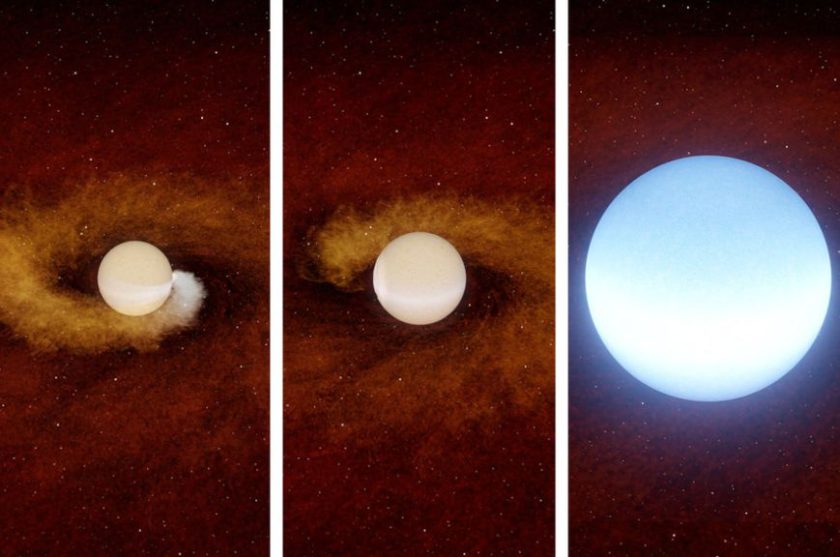
When a star runs out of fuel, it eventually reaches the end of its life cycle and begin to expand. It swells to hundred or even a thousand times its original size.
The process is called as a “red giant” phase. The progression enables the star’s outer layers to become less dense. Consequently, the star starts to swell outwards.
In some cases, the star may expand so much that it engulfs any nearby planets.
Although, the entire process is not sudden. The star’s outer layers expand gradually over millions or billions of years, giving any nearby planets time to adjust their orbits or be destroyed by the star’s increased gravitational pull.
The act of consuming entire planets, however, have never been caught until now.
The planetary demise
Lately, astronomers at MIT, Harvard University, and Caltech, have observed a star swallowing a planet, for the first time.
The star, located in the constellation Aquila, experienced a sudden increase in brightness, becoming more than 100 times brighter over just 10 days. This was followed by a slower, longer-lasting brightening that lasted for several months.
Based on their observations, the astronomers concluded that the most likely explanation for the event was that the star had consumed a nearby planet, which produced a burst of light and energy.
This was followed by a slower brightening as the debris from the destroyed planet was heated and radiated energy.
Stellar tidal disruption
The planet was likely a hot, Jupiter-sized world that spiraled close to the star before meeting its ultimate demise.
Kishalay De, a postdoc at MIT’s Space Research postulated that the same fate will eventually befall the Earth, but not for another 5 billion years. Since the sun is expected to burn out and burn up the solar system’s inner planets.
The author notes that this scenario could be observed by other civilizations from far away, and they would see the sun suddenly brighten as it ejects some material before settling back to what it was.
This observation highlights the fact that the universe is constantly changing and evolving, and that all things must eventually come to an end, including stars and planets.
However, it is important to note that the 5-billion-year timeline is an estimation based on current scientific understanding and models, and future discoveries may alter this timeline.
The outbursts were observed in 2020
Astronomers typically gather data from various telescopes and instruments to study astronomical events thoroughly.
Therefore, the current research was initiated in May 2020. As it was the same time, the scientists had discovered the outburst.
But it took subsequent year for them to piece together an explanation for what the outburst could be.
Watching a star gulping down a planet in real time
Initially, the researchers took data – from the Zwicky Transient Facility (ZTF), run at Caltech’s Palomar Observatory in California – for signs of eruptions in stellar binaries.
The pattern resembled the signatures of supernovae, gamma-ray bursts, and other stellar phenomena.
Further, to discern the star’s chemical composition, the team took spectroscopic measurements of starlight via the Keck telescopes.
Peculiar molecules existing at cold temperatures
De said that they were surprised by the incoming data. They observed signs of “peculiar molecules” that can only exist at very cold temperatures. Low temperatures and brightening stars do not go together, he further added.
Eventually, the team decided to use an infrared camera at the Palomar Observatory. As it allowed them to see signals of colder material that wouldn’t have been visible in the optical band.
This is because colder material emits radiation at longer wavelengths, which fall within the infrared spectrum.

A stellar merger
By analysing these infrared observations, the team was able to rule out the possibility that the signal was coming from a stellar binary, as these typically emit white-hot, optical emissions.
Instead, they were able to identify the presence of colder material, which suggested that the outburst was likely caused by a different phenomenon – such as a stellar merger, rather than a supernova explosion.
The continued ejection of this material over the course of a year suggests that the outburst was not a one-time event but a more sustained process, consistent with a stellar merger.
When two stars merge, they can create an extended envelope of ejected material that continues to expand and cool over time, emitting radiation in the infrared band.
Takeaway
The discovery of a star undergoing a planetary engulfment event in real-time is indeed very exciting for astronomers.
As the quote mentions, scientists have been able to observe the aftermath of such events for decades, but catching a star in the act of engulfing a planet provides a rare opportunity to study this process in much greater detail.
The discovery could provide a better understanding of how planetary systems form and evolve.
It could shed light on the processes that determine which planets survive and which ones are engulfed by their parent star, and how these processes vary depending on the characteristics of the planets and their orbits.



